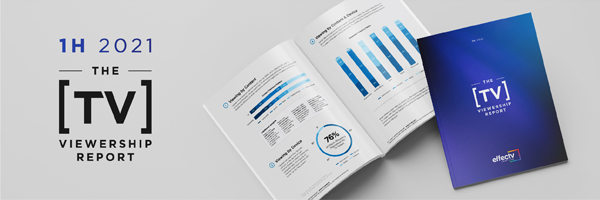Research: Combining Streaming Ads with Linear TV Ads Boosts Campaign Effectiveness
New research from Comcast’s ad sales division also found that 88% of TV viewing in Comcast homes was on live linear TV

NEW YORK—The ad sales division of Comcast Cable, Effectv, has released a new TV Viewership Report that shows that cross platform ad campaigns combining streaming ads with live linear TV spots expands the campaign reach and effectiveness.
The report, which covers Comcast aggregate household viewing data for the first half of 2021, also found that there was a lot of life left in live linear TV viewing in cable homes. Consumers spent an average of 6+ hours per day watching TV, with 88% of that time spent watching live linear TV, and 70% spent on cable TV.
According to an analysis of more than 20,000 Effectv cross-platform campaigns, streaming consistently served as a strong complement to traditional TV campaigns in the first half of 2021. In fact, 57% of reach from streaming in those campaigns was incremental to linear TV campaigns, the report said.
Additionally, streaming impressions were +209% more likely to be served within households that viewed little or no traditional TV. This proves that complementing traditional TV strategies with premium long-form streaming will grow incremental reach and increase exposure with households less likely to be tuning in the traditional way, the company said.
"Our latest report continues to demonstrate the tremendous ability of linear TV to reach audiences, but it also reinforces how smart advertisers use streaming as a way to expand reach,” said John Brauer, vice president, insights and analytics at Effectv. “Analysis of Effectv’s cross-platform audience solutions confirm what the industry has long suspected: streaming advertising consistently extends traditional TV campaign reach in meaningful ways.”
Looking at consumer viewing trends overall, the report found that live TV viewership grew in the first half of 2021, reaching 88% of all TV viewing. This was true both on weekdays and weekends, as an overwhelming majority of programming, including sports, was watched live on TV rather than on DVR or Video on Demand.
In total, the findings revealed that Comcast households are spending on average 6 hours and 2 minutes with TV daily, totaling 15 billion hours of TV viewing during this time period. Of that time spent with TV, 70% was spent with cable TV, higher than previous recorded years.
The professional video industry's #1 source for news, trends and product and tech information. Sign up below.
Viewers spread their consumption of premium video content across multiple networks and devices, and at different times of day. Nearly 70% of live viewing occurred outside of primetime hours.
The report also found that Comcast households watched an average of 30 different networks during this period, and the top five networks only accounted for only 31% of all viewing in 1H2021. This suggests that advertisers shouldn’t rely on the “most-watched” networks or primetime alone to achieve scale, the company said.
The report also uncovered interesting differences in how and when viewers choose to watch TV versus streaming their favorite shows. For example, viewers were +214% more likely to watch news and +73% more likely to watch sports on traditional TV versus streaming. In comparison, they were +153% more likely to watch young adult content via streaming instead of TV.
Overall, the report found the TV is still the device of choice for viewers, even when watching streaming content. According to the study, 76% of streaming viewing still occurred on a TV screen in 1H2021.
The full TV Viewership Report for 1H2021 can be found here.
George Winslow is the senior content producer for TV Tech. He has written about the television, media and technology industries for nearly 30 years for such publications as Broadcasting & Cable, Multichannel News and TV Tech. Over the years, he has edited a number of magazines, including Multichannel News International and World Screen, and moderated panels at such major industry events as NAB and MIP TV. He has published two books and dozens of encyclopedia articles on such subjects as the media, New York City history and economics.

